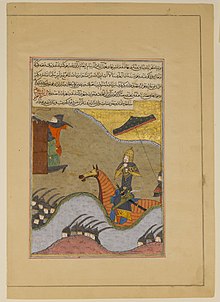
Back ظفرنامه تیموری Persian ज़फ़रनामा (यज़्दी जीवनी) Hindi 승전기 Korean சாபர்னாமா (எசுதி) Tamil Zafernâme (Şerafeddin Ali Yezdî) Turkish Zafarnoma (asar) Uzbek

The Zafarnama (Persian: ظفرنامه, lit. 'Book of Victories') is a panegyric book written by Sharaf al-Din Ali Yazdi approximately two decades after the death of its main subject, Timur, the Turco-Mongol conqueror. It was commissioned by Ibrahim Sultan, Timur's grandson between 1424–28, and remains one of the best-known sources of Timur's life.[1] The text was written using the notes taken by royal scribes and secretaries of Timur, suggesting that the history of the book was based on a careful and desired selection of facts.
Most of the poetry and texts in the beginning of Islamic Iran were panegyric, written at the demand of political and religious leaders as part of their attempt to establish their own legacy. In his lifetime, Timur wished that his deeds would be commemorated through clear and simple language.[2] However, the Zafarnama has a decent amount of hyperbolic language and panegyric sentiment, revealing that the current literary tastes of the next generation of writers prevailed over Timur's wishes.[2] The Zafarnama was often copied and illustrated in Persia before making its way to being translated into Chagatai under the Uzbeks, and into Ottoman Turkish during the 16th century. More recently, the Zafarnama was translated into French in 1722 by François Pétis de la Croix and into English the following year.

The Zafarnama of Yazdi is one of several fifteenth-century texts that highlights Timur's leadership and military accomplishments. Sharaf al-Din Ali Yazdi relied on these previous texts about Timur's career as a conqueror to influence his text of the Zafarnama. One of his main influences was a biography written by Nizam al-Din Shami in 1404.[1] An example of proof of this statement is the use of Ghiyas al-Din Ali's story detailing Timur’s experience in India (the Ruz-Name-ye Ghazavat-e Hindustan) that is present in both versions of the Zafarnama that are decades apart. In 1410, one of Timur's sons, Shah Rukh, demanded an updated version of his father's history. By then, the original Zafarnama's author, Nizam al-Din Shami, had died so another scribe, Taj al-Salmani, finished the manuscript and put Timur's last few years onto paper.[2] These textual precedents were important to the creation of the Zafarnama of Sultan Husayn, as they dictated the content of the text in the manuscript.
© MMXXIII Rich X Search. We shall prevail. All rights reserved. Rich X Search